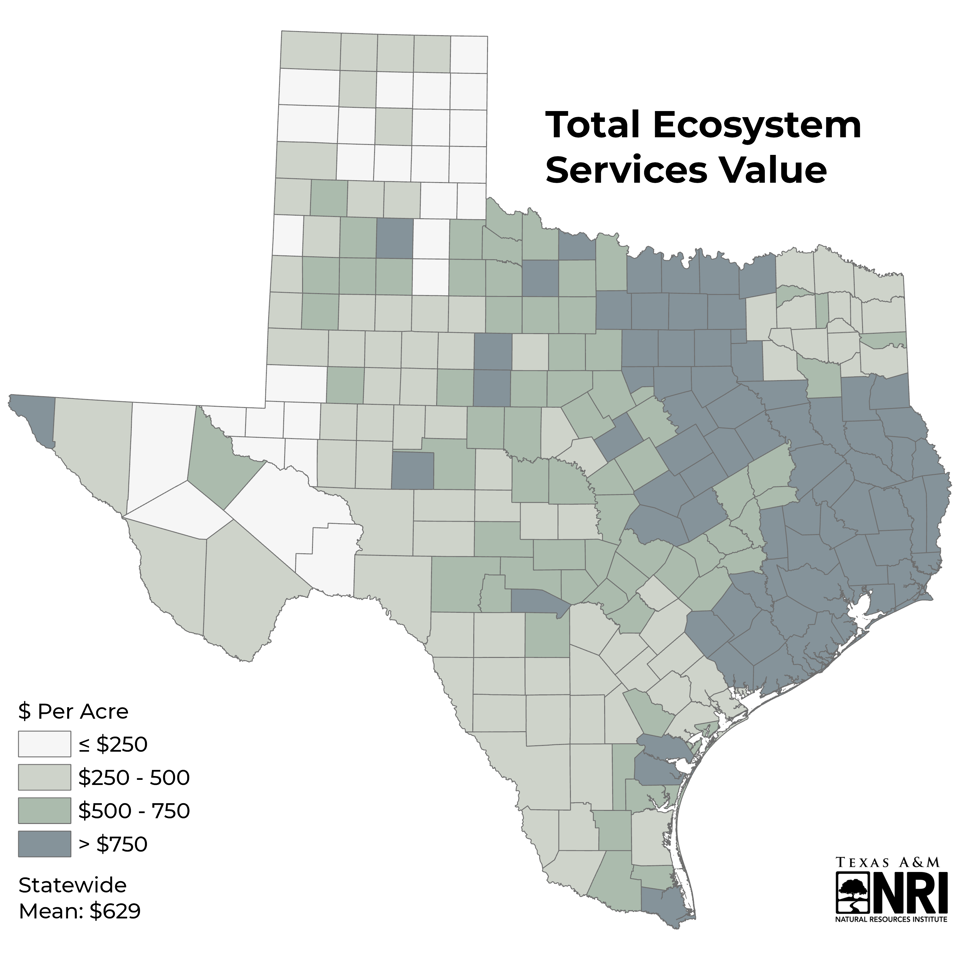

Announcing the new statewide assessment: Putting a dollar amount to Texas ecosystem services
November 14, 2022
Lady Bird Johnson had a way with words that resonates with Texans of all walks of life still today. Her work to encourage the conservation and use of native plants to restore and create sustainable landscapes brought to life so many of her views of the natural environment. During a speech at Yale University in 1967, she said, “The environment is where we all meet, where we all have a mutual interest; it is the one thing all of us share.”
As we consider her words, we maintain this ecological conviction to support our environment and hone in on the more critical responsibilities we have to manage the diverse landscapes of Texas that provide vital goods and services that benefit all of us. Referred to as the “commodities of nature”, these ecosystem services are the set of functions benefiting human wellbeing, encompassing many life-sustaining outputs such as climate regulation, air purification, and pollination. Many of these ecosystem services are traditionally considered shared, free to society—and commonly overlooked—like clean air, clean water, and flood control provided by healthy forest, range, and wetland ecosystems.
Although an important component of natural landscapes, as well as our daily quality of life, ecosystem services typically lack formal market structures, and their associated benefits are difficult to quantify or appropriately value on paper as we weigh the benefits and costs of growth and expansion and consider natural resource challenges. How do you put a dollar value on clean air and water, for example? In some ways, these are arguably “priceless,” but, as a result, their contributions and importance are often assumed or missed altogether by the general public, government leaders, and those involved in land use decision-making. We set out to level this field, so to speak.
Promoting the long-term sustainability and stewardship of natural resources begins with a basic understanding of ecosystem services and their public benefits. Ideally, the ability to assign monetary value can illustrate the importance of their fundamental contributions to society. An analysis like this can serve to support land conservation strategies and policies to promote the conservation of open spaces and natural resources. Thus, the objectives of this assessment are to:
- provide examples of broad ecosystem services, and
- estimate their relative economic value or level of current investments to maintain their benefits.
We are grateful for the insights and support from the Texas Agricultural Land Trust and the Natural Resources Conservation Service, as we couldn’t have achieved this assessment without their daily commitment to land and natural resource stewardship in Texas.
As a baseline for our work to promote the benefits and costs of ecosystem services, we assign a collective value in the assessment for four ecosystem service categories to include: provisioning, regulating, cultural and supporting services, each uniquely defined for their attributes like tangible goods, ecosystem processes, non-material benefits and ecological functions.
In the report, we cover in detail the methodologies used to assign dollar values based on market-based estimates from the Texas Comptroller of Public Accounts and the Texas Water Development Board (TWDB) where appropriate, and willingness-to-pay estimates from established federal field-scale or operation-level conservation programs through the Natural Resources Conservation Service. The market-based estimates utilize current financial mechanisms to calculate the market value of an ecosystem service. For example, food and fiber production are tangible products that are already included in a traditional market system where people regularly buy and sell these goods and services. Existing data can tell us how much a crop is worth and what it contributes to our market economy. Market-based estimates utilize this existing data—what we know we already pay—to assign values to ecosystem services. In contrast, a willingness-to-pay model utilizes the maximum value a consumer is willing to pay for a given good or service. For the purposes of this study, we used government payments to federal landowner incentive programs to determine the level of investment of federal government programs to conserve or protect previously identified ecosystem services in Texas.
For each ecosystem services category, the report summarizes all values to get one total ecosystem service value for the whole of Texas.
The report also includes maps for each category from Food and Fiber Production to Flood Mitigation and Non-consumptive Recreation revealing trends that will ultimately provide clarity for policy makers, conservation organizations, and land managers who can gain a better grasp of the full economic and ecological benefit Texas receives from vital open space lands—and the cost of continuing to overlook their natural contribution to society.
Taking a step back, we can now ask definitively what the cost of losing land is in Texas. By these conservative findings, it’s about $629 per acre or, when we consider that we’re losing about 640 acres per day to land conversion, it’s about $146,934,400 per year in ecosystem services value. That’s the price we pay, climbing each year, as we convert more land to accommodate population growth in Texas. At the end of the day, we need to keep farmers, ranchers, forestry owners—land stewards—on the land to grow food, conserve water and preserve wildlife habitat. Their work provides the environment where we all meet, where we all have a mutual interest, and that provides benefits that we all share.
Learn More
Land & water trends
Informing private and public decision-makers about the status and trends of our state’s working lands








